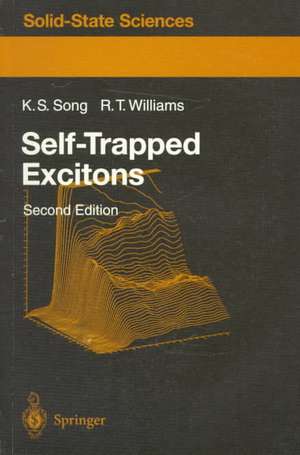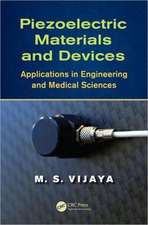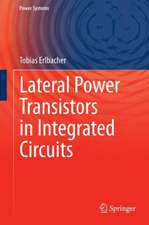Self-Trapped Excitons: Springer Series in Solid-State Sciences, cartea 105
Autor K. S. Song Cuvânt înainte de Y. Toyozawa Autor Richard T. Williamsen Limba Engleză Paperback – 18 mar 1996
Din seria Springer Series in Solid-State Sciences
- 18%
 Preț: 1225.94 lei
Preț: 1225.94 lei - 18%
 Preț: 1017.62 lei
Preț: 1017.62 lei - 15%
 Preț: 532.05 lei
Preț: 532.05 lei - 18%
 Preț: 944.51 lei
Preț: 944.51 lei -
 Preț: 541.47 lei
Preț: 541.47 lei - 18%
 Preț: 956.96 lei
Preț: 956.96 lei -
 Preț: 385.84 lei
Preț: 385.84 lei - 18%
 Preț: 1827.48 lei
Preț: 1827.48 lei - 15%
 Preț: 661.02 lei
Preț: 661.02 lei -
 Preț: 389.88 lei
Preț: 389.88 lei - 15%
 Preț: 639.59 lei
Preț: 639.59 lei - 15%
 Preț: 635.15 lei
Preț: 635.15 lei - 15%
 Preț: 647.92 lei
Preț: 647.92 lei - 15%
 Preț: 651.34 lei
Preț: 651.34 lei - 18%
 Preț: 890.23 lei
Preț: 890.23 lei - 15%
 Preț: 640.55 lei
Preț: 640.55 lei - 15%
 Preț: 649.54 lei
Preț: 649.54 lei - 15%
 Preț: 645.60 lei
Preț: 645.60 lei - 15%
 Preț: 644.30 lei
Preț: 644.30 lei - 15%
 Preț: 653.79 lei
Preț: 653.79 lei - 18%
 Preț: 956.69 lei
Preț: 956.69 lei - 15%
 Preț: 637.59 lei
Preț: 637.59 lei - 23%
 Preț: 1043.42 lei
Preț: 1043.42 lei - 15%
 Preț: 639.08 lei
Preț: 639.08 lei - 15%
 Preț: 648.24 lei
Preț: 648.24 lei - 15%
 Preț: 637.46 lei
Preț: 637.46 lei - 15%
 Preț: 640.06 lei
Preț: 640.06 lei -
 Preț: 391.40 lei
Preț: 391.40 lei -
 Preț: 390.84 lei
Preț: 390.84 lei - 15%
 Preț: 638.57 lei
Preț: 638.57 lei - 18%
 Preț: 1006.06 lei
Preț: 1006.06 lei - 18%
 Preț: 730.79 lei
Preț: 730.79 lei - 15%
 Preț: 640.37 lei
Preț: 640.37 lei - 15%
 Preț: 643.65 lei
Preț: 643.65 lei - 18%
 Preț: 1231.01 lei
Preț: 1231.01 lei - 18%
 Preț: 950.21 lei
Preț: 950.21 lei - 15%
 Preț: 642.68 lei
Preț: 642.68 lei - 15%
 Preț: 640.55 lei
Preț: 640.55 lei - 18%
 Preț: 1229.10 lei
Preț: 1229.10 lei
Preț: 896.21 lei
Preț vechi: 1092.93 lei
-18% Nou
Puncte Express: 1344
Preț estimativ în valută:
171.50€ • 183.38$ • 142.98£
171.50€ • 183.38$ • 142.98£
Carte tipărită la comandă
Livrare economică 18 aprilie-02 mai
Preluare comenzi: 021 569.72.76
Specificații
ISBN-13: 9783540604464
ISBN-10: 3540604464
Pagini: 428
Ilustrații: XIV, 410 p. 7 illus., 2 illus. in color.
Dimensiuni: 155 x 235 x 22 mm
Greutate: 0.59 kg
Ediția:Softcover reprint of the original 2nd ed. 1996
Editura: Springer Berlin, Heidelberg
Colecția Springer
Seria Springer Series in Solid-State Sciences
Locul publicării:Berlin, Heidelberg, Germany
ISBN-10: 3540604464
Pagini: 428
Ilustrații: XIV, 410 p. 7 illus., 2 illus. in color.
Dimensiuni: 155 x 235 x 22 mm
Greutate: 0.59 kg
Ediția:Softcover reprint of the original 2nd ed. 1996
Editura: Springer Berlin, Heidelberg
Colecția Springer
Seria Springer Series in Solid-State Sciences
Locul publicării:Berlin, Heidelberg, Germany
Public țintă
Professional/practitionerCuprins
1 Introduction.- 1.1 Excitons.- 1.2 Charge Carriers and Excitons in a Deformable Lattice.- 1.3 Scope of this Monograph.- 2 Investigation of Self-Trapped Excitons from a Defect Perspective.- 2.1 Atomistic Structure of Self-Trapped Carriers.- 2.2 Self-Trapped Excitons.- 2.3 Experimental Methods.- 2.4 Theoretical Methods.- 3 Condensed Rare Gases.- 3.1 Electronic Structure.- 3.2 Spectroscopy.- 3.3 Theory of the Self-Trapped Exciton in Rare-Gas Solids.- 3.4 Desorption from the Surface.- 4 Alkaline Earth Fluorides.- 4.1 Electronic Structure.- 4.2 Lattice Defects.- 4.3 Theory of Self-Trapped Excitons in Fluorite Crystals.- 4.4 Spectroscopy.- 4.5 Lattice Defect Formation.- 5 Alkali Halides.- 5.1 Material Properties.- 5.2 Theory of Self-Trapped Exciton Structure.- 5.3 Luminescence.- 5.4 Magneto-Optics, ODMR, and ODENDOR.- 5.5 Excited-State Absorption.- 5.6 Resonant Raman Scattering.- 5.7 Dynamics.- 5.8 Kinetics.- 6 Defect Formation in Alkali Halide Crystals.- 6.1 Self-Trapped Excitons as Nascent Defect Pairs.- 6.2 Thermally Activated Conversion.- 6.3 Dynamic Conversion Process.- 6.4 Stabilization of the Primary Defects.- 6.5 Defects and Desorption at Surfaces.- 7 Silicon Dioxide.- 7.1 Material Properties.- 7.2 Theory of Self-Trapped Excitons.- 7.3 Experiments on Crystalline SiO2.- 7.4 Experiments on Amorphous SiO2.- 7.5 Self-Trapped Holes in SiO2.- 7.6 Defect Generation Processes.- 8 Simple Organic Molecular Crystals.- 8.1 Material Properties.- 8.2 Pyrene.- 8.3 Anthracene.- 8.4 Perylene.- 9 Silver Halides.- 9.1 Electronic Structure and Exciton Spectra.- 9.2 Self-Trapped Hole in AgCl.- 9.3 Self-Trapped Exciton in AgCl.- 10 As2Se3 and Other Chalcogenides.- 10.1 Structure and Electronic States of As2Se3.- 10.2 The Self-Trapped Exciton.- 10.3 Spectroscopy.- 10.4 STE to Defect Conversion in Amorphous Chalcogenides.- 10.5 Spectroscopy in Crystalline Trigonal Selenium.- 11 Other Materials, Extrinsic Self-Trapping, and Low-Dimensional Systems.- 11.1 Ammonium Halides.- 11.2 KMgF3 and Related Perovskites.- 11.3 Alkaline-Earth Fluorohalides.- 11.4 Alkali Silver Halides.- 11.5 LiYF4.- 11.6 Extrinsic Self-Trapping in ZnSeTex.- 11.7 Quasi-One-Dimensional Systems.- References.













